Steps on How to Maintain Your Home's Hot Water System ProperlyEffective Techniques for Maintaining Your Home's Hot Water System
Steps on How to Maintain Your Home's Hot Water System ProperlyEffective Techniques for Maintaining Your Home's Hot Water System
Blog Article
Do you find yourself in search of answers around Tips For Maintaining Your Hot Water Heater?

Hot water is vital for daily comfort, whether it's for a refreshing shower or washing dishes. To ensure your hot water system runs effectively and lasts longer, routine maintenance is essential. This short article offers functional ideas and understandings on exactly how to maintain your home's hot water system to prevent interruptions and pricey repairs.
Introduction
Keeping your home's warm water system may seem complicated, however with a few simple actions, you can guarantee it runs efficiently for many years to find. This guide covers everything from recognizing your hot water system to DIY upkeep ideas and knowing when to call in expert assistance.
Relevance of Preserving Your Hot Water System
Regular maintenance not just extends the life-span of your warm water system yet likewise ensures it runs efficiently. Disregarding maintenance can bring about reduced efficiency, greater energy bills, and even premature failure of the system.
Indicators Your Warm Water System Requirements Maintenance
Recognizing when your hot water system requires focus can avoid significant problems. Look out for signs such as inconsistent water temperature level, weird noises from the heater, or rusty water.
Flushing the Hot Water Heater
Purging your water heater removes sediment build-up, boosting effectiveness and extending its life.
Checking and Replacing Anode Rods
Anode poles stop rust inside the tank. Evaluating and changing them when worn out is crucial.
Facility Problems Requiring Professional Aid
Examples consist of major leakages, electric issues, or if your hot water heater is consistently underperforming.
Regular Professional Upkeep Perks
Professional upkeep can include extensive evaluations, tune-ups, and making sure compliance with security criteria.
Checking and Changing Temperature Setups
Adjusting the temperature level setups guarantees optimum performance and safety and security.
DIY Tips for Upkeep
You can perform a number of upkeep tasks on your own to keep your warm water system in leading condition.
Looking for Leaks
On a regular basis check pipes and links for leakages, as these can result in water damages and higher costs.
Understanding Your Warm Water System
Prior to diving into maintenance jobs, it's handy to understand the basic elements of your warm water system. Generally, this consists of the water heater itself, pipes, anode poles, and temperature level controls.
Monthly Maintenance Tasks
Routine month-to-month checks can help capture minor problems prior to they escalate.
Evaluating Pressure Alleviation Valves
Examining the stress relief valve guarantees it functions properly and stops too much stress build-up.
Insulating Pipes
Protecting warm water pipelines lowers heat loss and can save energy.
When to Call a Professional
While DIY upkeep is valuable, some issues require specialist experience.
Conclusion
Routine upkeep of your home's warm water system is important for performance, longevity, and cost savings. By complying with these suggestions and knowing when to seek professional help, you can guarantee a reputable supply of hot water without unforeseen interruptions.
How to Maintain an Instant Hot Water Heater
Before tinkering with your hot water heater, make sure that it’s not powered on. You also have to turn off the main circuit breaker and shut off the main gas line to prevent accidents. Also turn off the water valves connected to your unit to prevent water from flowing into and out of the appliance. 2. When you’re done, you have to detach the purge valves’ caps. These look like the letter “T” and are situated on either side of the water valves. Doing so will release any pressure that has accumulated inside the valves while at the same time avoid hot water from shooting out and burning your skin. 3. When the purge valves’ caps are removed, you have to connect your hosing lines to the valves. Your unit should have come with three hoses but if it didn’t, you can purchase these things from any hardware or home repair shops. You can also get them from retail stores that sell water heating systems. Read the user’s manual and follow it to complete this task properly. When the hosing lines are connected, open the purge port’s valves. 4. You should never use harsh chemical cleaners or solutions when cleaning your unit. Make use of white vinegar instead. It should be undiluted and you’ll probably use about 2 gallons. 5. Now flush your water heater. This task should probably take about 40 minutes. We can’t give you specific directions for this because the procedure is carried out depending on the type, model and brand of your heater. With that being said, refer to the user’s manual. 6. When you’re done draining the unit, you have to turn off the purge port valves again. Remove the hosing lines that you earlier installed on each of the water valves. Put the valve caps (purge port) back in their respective places and be very careful so as not to damage the rubber discs that are found inside these caps. 7. Now that everything’s back in place, check your user’s manual again to find out how to reactivate your water heating system. 8. Once it is working, turn one of your hot water faucets on just to let air pass through the heater’s water supply pipes. Leave the tap on until water flows smoothly out of it. https://www.orrplumbing.com/blog/2014/september/how-to-maintain-an-instant-hot-water-heater/

Hopefully you enjoyed reading our piece on How to Maintain Your Water Heater & Prolong its Life. Thanks so much for finding the time to browse our posting. Enjoyed our write-up? Please quickly share it. Help somebody else discover it. I treasure reading our article about Tips For Maintaining Your Hot Water Heater.
Or Book Technician Here Report this page